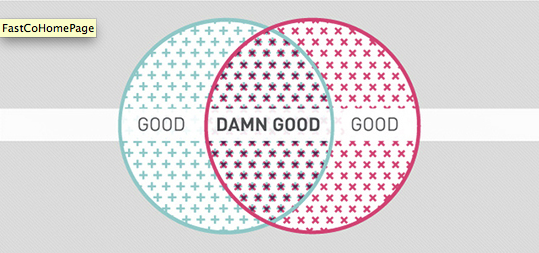This is a great Article from Fast Company that gives some interesting ideas for mashups. You can read the original article here.
STARTUPS’ MISSED CONNECTIONS
BY MELISSA SILVERS, CREATIVE DIRECTOR, READY SET ROCKET
Too many services and apps and their associated APIs are passing right by each other like strangers in the night. Why aren’t we seeing more mashups like Pinstagram (Pinterest + Instagram, get it?). Or more creative thinking around social networks, like the service created by the Financial Times at LinkedIn’s recent hack day, which lets users see where people in their network donated political dollars. We want to see these kinds of things pushed further, even outside of hackathons. Why isn’t Match.com smushing with Mint.com to discover love connections based on spending habits–sex and money, after all, are two of the biggest factors in relationships. Why isn’t Spotify partnering with Ticketmaster for live ticket purchasing?
At Ready Set Rocket, we’ve done plenty of work that takes advantage of APIs for infographics and interactive products (several for Fast Company). But we want to help advance more of these ideas between otherwise walled-off networks and services, and encourage opening APIs. So we’ve decided to float off these ideas and come up with concepts for what it all might look like. Of course, we’d like to win a few opportunities to build these things. But everybody wins if we start talking more about mashups in purely inspirational terms. So let’s get a few of these ideas mingling. Let’s play matchmaker.
MINT.COM + MATCH.COM

Personal finances are often an uncomfortable subject–and mostly avoided early in relationships. Yet, sex and money are two of the most common reasons relationships fail. While an online dating site can’t guarantee physical chemistry, what if it could forecast financial chemistry?
That’s the idea behind this mashup. What if personal finance site Mint.com and dating site Match.com combined their platforms and data? Personal financial data, derived from credit card and bank account activity, could be visually illustrated in meaningful, big-picture ways for potential mates.
Potential matches could be suggested based upon verified spending habits or lifestyles inferred by spending patterns. Are you a spender? A saver? Do you love cooking (grocery bills) or eating out (lots of restaurant spending). Are you a sports enthusiast? Do you travel?
By leveraging financial data, Match.com could remove the biased nature of a person filling out a survey (answering how they think someone would want them to) and expose a visual snapshot of a person’s overall financial habits and their hobbies, interests, and lifestyle inferred from such data.
PINTEREST + GOOGLE IMAGE SEARCH
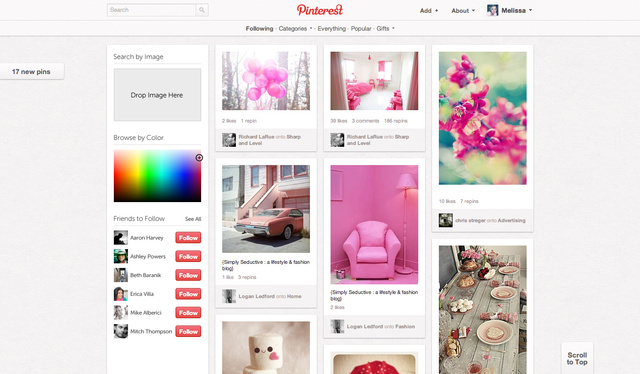
Pinterest is not only the indulgent fantasy world of crafts, fashion, and food for users who spend countless hours scrolling and pinning, but it is also becoming a search tool. Even our own creative department is starting to use Pinterest as the start of search–typing in “hand lettering” for example provides a much more curated, higher-quality result than, let’s say, a Google Image search for the same thing.
The demand for web curation has arrived in full form and Pinterest is the slickest line through the trend. Pinterest knows it’s a discovery and collection tool (and maybe even a tool to broadcast your personality); problem is, Pinterest doesn’t know it’s a search tool (or hasn’t actualized this potential in any meaningful way).
In an ideal world, Pinterest and Google Image Search would marry their platforms and technology. If Pinterest had a search-by-color option (find color-matched images simply by clicking a color within a spectrum). Or, leverage Google Image Search’s drag & drop image search feature (find an image you like on Pinterest and then search to find visually similar images).
Sometimes, there aren’t words for what you are looking for. But expanding Pinterest to fully encompass visual search tools will solidify its place in the world of curated search.
SEAMLESS.COM + NYC RESTAURANT GRADES
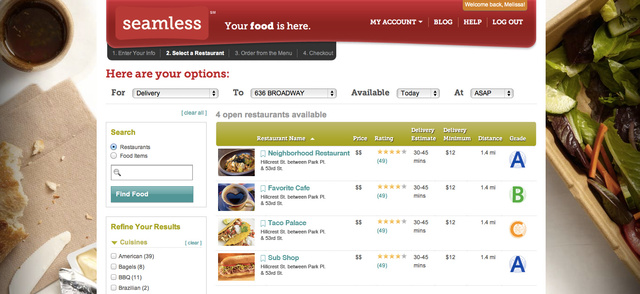
Any New Yorker (and a couple of other states) are familiar with the restaurant grading system. Clearly posted by the door before walking into a restaurant, is a white piece of paper with a 525-pt. letter that says ”A,” “B,” “C,” etc. (Really anything other than an A is pointless, but that’s another story.) These are restaurant grades provided by the Health Department that do a very visual job of letting diners know how the restaurant ranked on their last health inspection.
While there’s some controversy on the actual grading system, we side on the side of not getting botulism and heartedly welcome the grades. But much to the horror of germophobes everywhere, delivery services such as Seamless.com don’t have to display the grades on the site’s “virtual door front.”
If the NYC Dept. of Health and Mental Hygiene released an API for their grading database (which they do house online, but who goes that extra step of research?), it could be a simple plugin for Seamless.com, and all the virtual Grade posts could happen, well, seamlessly.
SPOTIFY + TICKETMASTER
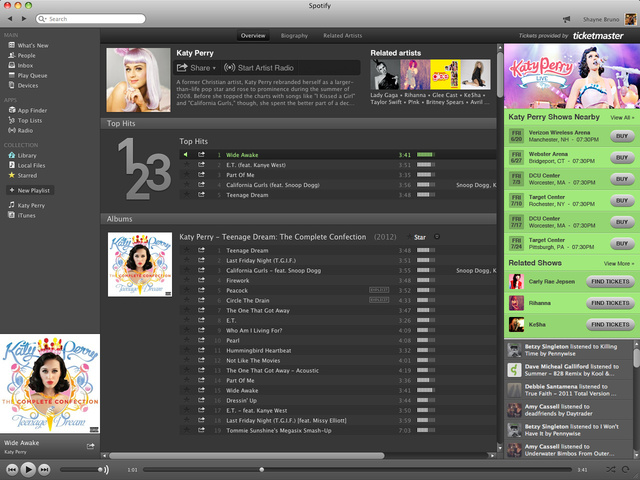
The recent boom in online music services such as Pandora, GrooveShark, Songza, Turntable.fm, and Spotify have us all rocking out from any Internet-enabled device. Suddenly, the world of music is open to us, and their savvy algorithms suggest music through complex tagging and listening habits, and their social tools let us tell people about ourselves via curated, shared playlists.
But any real music enthusiast feels something is missing. What if Spotify were able to align its algorithm with the ticket/concert data base of Live Nation’s Ticketmaster? By pairing those to firehouses of info, a simple sidebar could be designed for the Spotify listener that exposes geotargeted, upcoming concerts by either the artist playing or similar artists.
Our agency’s vote was unanimous: Allow us to not only discover new music but buy tickets without ever having to leave the Spotify platform. We think it could not only be a great artist promotion tool, but also a way for a fan to make that impulse purchase while rocking out to a favorite song.
GROUPON + FACEBOOK PLACES + FOURSQUARE + GOWALLA
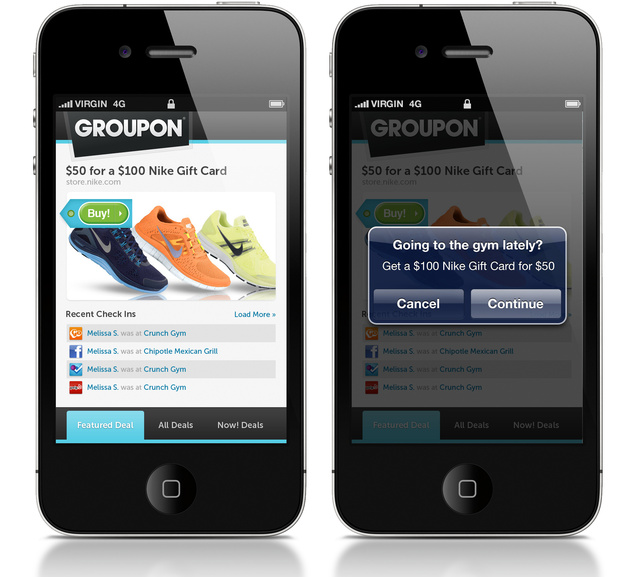
Groupon is based, at least on the surface, on the concept of masses combining buying power to unlock a deal. But there’s only so many spa services packages a girl can receive. While it’s true it provides geographically relevant discounts and some level of categorical interest selection, we can’t help but feel in the world of real-time, hyper-personalization, something is missing.
AND THE ORGY: GROUPON + FB PLACES + FOURSQUARE + GOWALLA + YELP!
If Groupon leveraged such social data from multiple incoming streams, they would unlock the opportunity to provide hyper-personalized offers based on your actual social behavior across multiple channels. Checking into a lot of bars? Enter more cocktail classes or rooftop bar experience offers. Going to the gym lately? Offers from Nike or a local personal training service.
We’d also bet it would provide Groupon some pretty awesome data to share with businesses in terms of demand and interest in crafting offers and discounts more meaningful to specific users.
We think that’s an idea people would buy into en masse.
[All images: Ready Set Rocket]
